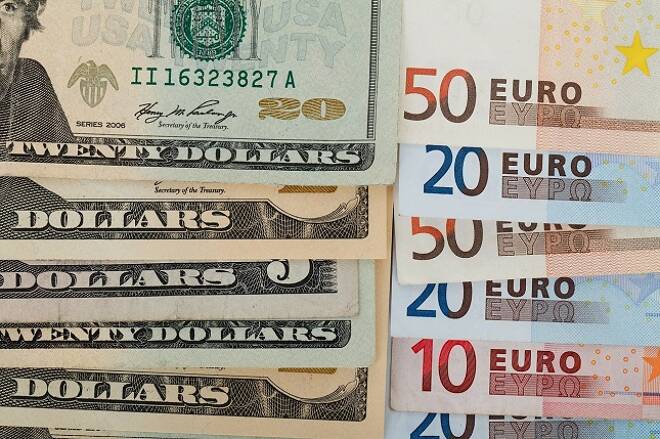Advertisement
Advertisement
EUR/USD Daily Technical Analysis for March 28, 2018
By:
The EUR/USD moved lower as sentiment in the Eurozone declined, reversing Monday’s climb. The ECB's Liikanen urges caution on tightening, while the ECB's
The EUR/USD moved lower as sentiment in the Eurozone declined, reversing Monday’s climb. The ECB’s Liikanen urges caution on tightening, while the ECB’s Visiliauskas hints at possibility of rate hike in H1 2019. Eurozone money supply was softer than expected and Spanish inflation was lower than forecast.
Technicals
The EUR/USD moved lower after climbing on Monday. The exchange rate retested support which was the former breakout level near 1.2370. Additional support is seen near the 10-day moving average at 1.2344. Resistance is seen near the February highs at 1.2555. Momentum is positive as the MACD (moving average convergence divergence) index recently generated a crossover sell signal. The fast stochastic generated a crossover sell signal after moving up into oversold territory.
ECB’s Visiliauskas hints at a possibility of rate hike in H1 2019
Similar to comments from Bundesbank President Weidmann, Governing Council member Visiliauskas said “markets forecast rate changes in the first half of 2019. From his vantage point, one could agree with such market forecast””. Praet last week also seemed to endorse market expectations for a move on rates in the first half of next year and while Visiliauskas stressed that the ECB can only have “deeper discussions” about the next policy changes when its projections are published in June, the shift to the focus on rates confirms that net asset purchases are on the way out. Visiliauskas added that the Eurozone economy is growing at a “stable pace”, so deliberations about changes in monetary policy are “completely natural”.
Eurozone ESI economic confidence sharply lower in March
Eurozone ESI economic confidence fell back to just 112.6 in March, from 114.2 in the previous month. This is the lowest number since September last year and together with the dip in PMI, ZEW and Ifo readings this month is highlights that sentiment is slipping back, which is heralding a slowdown in growth rates going forward. Still, also like the other confidence indicators, the ESI remains far above the long term average of just 101.2 and part of the slowdown in growth is also due to the fact that companies are running into capacity constraints and that growth rates can’t be sustained without an expansion in underlying growth potential.
ECB’s Liikanen urges caution on tightening
The Governing Council member said “a gradual tightening of monetary policy will rest on a more solid basis when indications of inflation to potentially temporarily exceed two per cent become more prominent in inflation expectations”, adding that “this way can we ensure that the Eurosystem’s price stability objective of below but close to 2% is symmetrical and can be attained in a sustainable manner even without additional support from monetary policy”. Pretty cautious comments that seem to actually imply a slightly higher inflation target, that is symmetrical around 2%, rather than below 2%. In the current situation though it doesn’t necessarily mean that he is arguing against a phasing out of QE, as that implies less stimulus, not really a tightening of monetary policy.
Eurozone money supply growth weaker than expected
Eurozone M3 money supply growth decelerated to 4.2% year over year in February, while the January number was revised down to 4.5% year over year from 4.6% year over year reported initially.
Spanish HICP lower than expected
The Spanish headline inflation rate accelerated to 1.3% year over year from 1.2% year over year in February but that was a much lower number than the 1.5/1.6% rate expected. This was the first of the big four Eurozone countries to release preliminary March numbers and if the numbers set the tone for the rest of the releases we are in for just a very muted pick up in Eurozone HICP. More arguments then for the doves at the ECB who still appear reluctant to commit to an end of net asset purchases.
German import price inflation weaker than expected at -0.6% year over year. Prices were also down -0.6% month over month. The sharp drop was mainly due to a -2.1% year over year decline in prices for consumer goods, which are likely impacted by a stronger EUR. Prices for imported agricultural products dropped 9.8% year over year, prices for capital goods dipped -1.2% year over year, while energy prices rose 3.0% year over year, after falling in January. Large swings and sizeable base effects, which were already evident in February HICP readings and thus come less of a surprise. Still, the weak headline reading will add to the arguments of the doves at the ECB, even if the data doesn’t have an impact on underlying inflation trends as long as the driving factors are temporary.
About the Author
David Beckerauthor
David Becker focuses his attention on various consulting and portfolio management activities at Fortuity LLC, where he currently provides oversight for a multimillion-dollar portfolio consisting of commodities, debt, equities, real estate, and more.
Did you find this article useful?
Latest news and analysis
Advertisement
